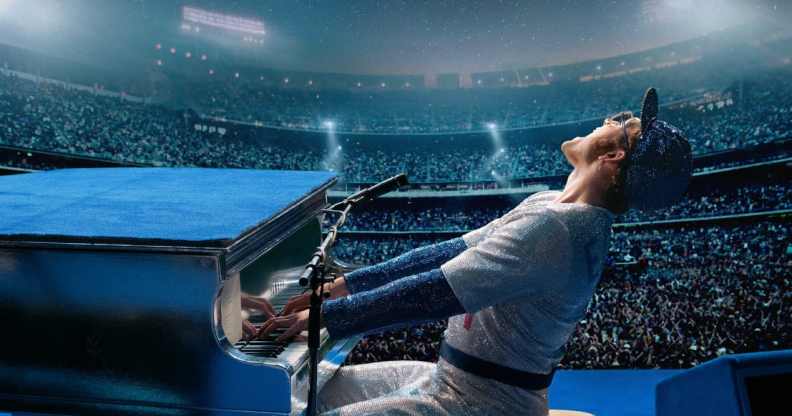Representation of white gay men is improving in big studio films – but other queer people are becoming increasingly invisible

Taron Egerton as Elton John in Rocketman. (Paramount Pictures)
The representation of white gay men is constantly improving in major studio films – but other queer people are becoming increasingly invisible.
LGBT+ organisation GLAAD released its eight annual Studio Responsibility Index yesterday (16 July), which looks at representation of queer characters in films released by eight major studios in 2019.
The report shows that representation for white gay male characters is improving all the time, but lesbian, bisexual and trans characters are being left behind, along with people of colour and disabled people.
For the report, GLAAD analysed LGBT+ representation in 118 films released last year by eight studios: Lionsgate, Paramount Pictures, Sony Pictures, STX Films, United Artists Releasing, Universal Pictures, Walt Disney Studios and Warner Bros.
Of those 118 films, 22 (18.6 per cent) included LGBT+ characters, marking a tiny increase from the year before (18.2 per cent).
Of those 22 films, 15 featured gay male characters (68 per cent), up from 55 per cent of films in 2018 – but representation of other queer people is lagging far behind.
Just eight major studio films (36 per cent) included lesbian characters last year, while just three films (14 per cent) featured bisexual characters.
Most notably, trans and non-binary characters were completely absent from major studio films last year – marking the third consecutive year such a glaring omission has occurred.
LGBT+ characters of colour are disappearing at an alarming rate from major studio releases.
GLAAD also drew attention to the worrying lack of LGBT+ characters of colour in 2019 film releases.
There were just 17 LGBT+ characters of colour in last year’s slate of films out of a total of 50 queer characters, meaning people of colour made up just 34 per cent of all queer characters last year. This is down from 42 per cent in 2018 and 57 per cent in 2017.
The advocacy organisation has insisted that at least half of all LGBT+ characters from major studios should be people of colour within the next two years.
Despite seeing a record high percentage of LGBT-inclusive films this year, the industry still has a long way to go in terms of fairly and accurately representing the LGBT+ community.
The report also found that the level of screen time for queer characters varied hugely between different films.
Just nine out of 22 films gave LGBT+ characters more than 10 minutes of screen time, while more than half of all queer characters – 28 out of 50 – had less than three minutes of screen time.
Disappointingly, 21 of those characters had less than one minute of screen time, making their appearances essentially negligible.
The GLAAD report also notes that some LGBT+ characters had such minor roles that they weren’t even given names.
Major films such as Avengers: Endgame and Frozen 2 were given a ‘fail’ by GLAAD.
The organisation has compiled a report on every major studio film released last year and given it a “pass” or a “fail” mark for its LGBT+ representation.
Major titles such as Bombshell, Cold Pursuit, Rocketman, Charlie’s Angels, A Dog’s Way Home and Booksmart all passed the advocacy organisation’s test.
But films such as Avengers: Endgame, Frozen 2, Toy Story 4 all failed to meet the organisation’s standard of adequate queer representation.
“Film has the power to educate, enlighten, and entertain audiences around the world and, in today’s divisive political and cultural climate, we must prioritise telling LGBT+ stories and the stories of all marginalised people,” said GLAAD president Sarah Kate Ellis.
“Despite seeing a record high percentage of LGBT-inclusive films this year, the industry still has a long way to go in terms of fairly and accurately representing the LGBT+ community.
“If film studios want to stay relevant to today’s audiences and compete in an industry that is emphasising diversity and inclusion, then they must urgently reverse course on the diminishing representation of LGBT+ women and people of colour, as well as the complete absence of trans characters.”

